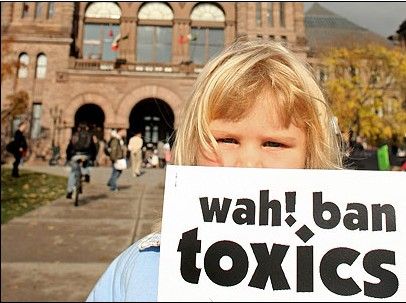 Researchers from Simon Fraser University, just a stone's throw from where I sit in Vancouver, have determined that the side effects from this endocrine disruptor can alter children's behavior:
Researchers from Simon Fraser University, just a stone's throw from where I sit in Vancouver, have determined that the side effects from this endocrine disruptor can alter children's behavior:
Researchers have just linked prenatal exposure to bisphenol-A - a near-ubiquitous industrial chemical - with subtle, gender-specific alterations in behavior among two year olds. Girls whose mothers had encountered the most BPA early in pregnancy tended to become somewhat more aggressive than normal, boys became more anxious and withdrawn.
Another recent study, by Joe Braun of the University of North Carolina in Chapel Hill (coincidentally, a slightly further stone's throw from where I used to be at Duke) has come to similar conclusions in a paper just released in the journal Environmental Health Perspectives:
The girls appeared somewhat masculinized, the boys a bit feminized. Then again, Braun points out, it's possible the girls' behavior reflected a defeminization or the boys a demasculinization. In other words, the production or action of their gender-establishing sex hormones might have been blocked.
Earlier I had a bit of a kerfuffle with National Review's Mark Hemingway who claimed that there was no science to warrant concern over BPA's effects on children (read the comments section of this post to see what he was hot and bothered about). Canada has made the wisest policy recommendations on BPA and has begun phasing out its use in children's products. But, of course, Americans might object because then they can't buy cheap plastic baby toys from Wal-Mart produced in some dungeon in Guangzhou.
I'm still waiting for Hemingway's update where he said he'd acknowledge his errors. But then, this is the National Review so I'm not holding my breath.

We recently covered BPA in a class on law, science, and technology in ASU's law school. The current status in the U.S. is that EPA restricts BPA to 1000 times the lowest observed adverse effect level in 1988 and reiterated that standard after review in 1993--that's 50 mcg/kg/day. The National Toxicology Program reviewed studies on BPA and rated its concerns, with "some concern" about some items such as developmental toxicity. Manufacturers have voluntarily begun removing BPA from products for children, especially baby bottles, though the replacement chemicals have not been studied. Wal-Mart and Toys-R-Us are phasing out products with BPA completely, as are Playtex and Nalgene. Some products which have claimed to be BPA-free, however, have been found to still contain it.
The FDA issued a risk assessment in August 2008 that said "an adequate margin of safety exists for BPA at current levels of exposure from food contact uses" based primarily on two industry-funded studies that met Good Laboratory Practices (GLP) standards and disregarded results from smaller academic studies that didn't meet GLP standards. In October 2008, an FDA advisory committee was convened, which concluded that the FDA was incorrect to disregard those results, and the FDA agreed to reassess and issue a new report by November 30, 2009.
Meanwhile, other countries are falling in line behind the U.S.--Norway, Switzerland, Germany, Denmark, Japan, Australia, and New Zealand have all come to the conclusion that there are no significant risks to BPA. Even the Prop. 65 Scientific Committee in California, which finds that just about everything is "known by the state of California to cause cancer" concluded that there are no significant risks to BPA.
Minnesota and Connecticut have banned BPA for children's bottles and cups, and there's a bill in Congress sponsored by Markey, Feinstein, and Schumer to ban BPA (the "Ban Poisonous Additives Act").
At this point, pretty much anything the FDA suggests means that's what industry wants. I encourage everyone to read through Harvard Law School's David Marc Solet's Strategies of Influence: How Corporate Power Directs and Constrains the FDA.
EMJ: That same objection can be made of every regulatory agency--that they become co-opted by the industries they regulate. It strikes me as, to some extent, inevitable since such industries have the incentives and the funds to lobby, while the general public has the problem of rational ignorance--lack of time, interest, and resources for countering that influence, though some NGOs can provide some counter if the topic is one that they can generate enough public concern about.
However, despite any co-option, the FDA scientific advisory committee told the FDA to reconsider its ruling in light of the non-GLP studies that found problems with BPA, and that's happening right now. It will be interesting to see what the Nov. 2009 report says. Further, the media attention and state actions seem to be sufficient to make changes in some corporate behavior despite lack of FDA regulation. I won't be at all surprised to see a proposed regulation to ban use of BPA in products for infants or pregnant women, though its presence in food can linings will present a big regulatory challenge.
There's the further problem of what potential impact there is from any replacement substances, that have not been subjected to anywhere near the level of scrutiny BPA has received.
The study you link to has a pretty serious criticism made against it in the comments by "StatStan"--that it made "at least 18 statistical comparisons and the statistical analysis was not corrected for multiple testing."